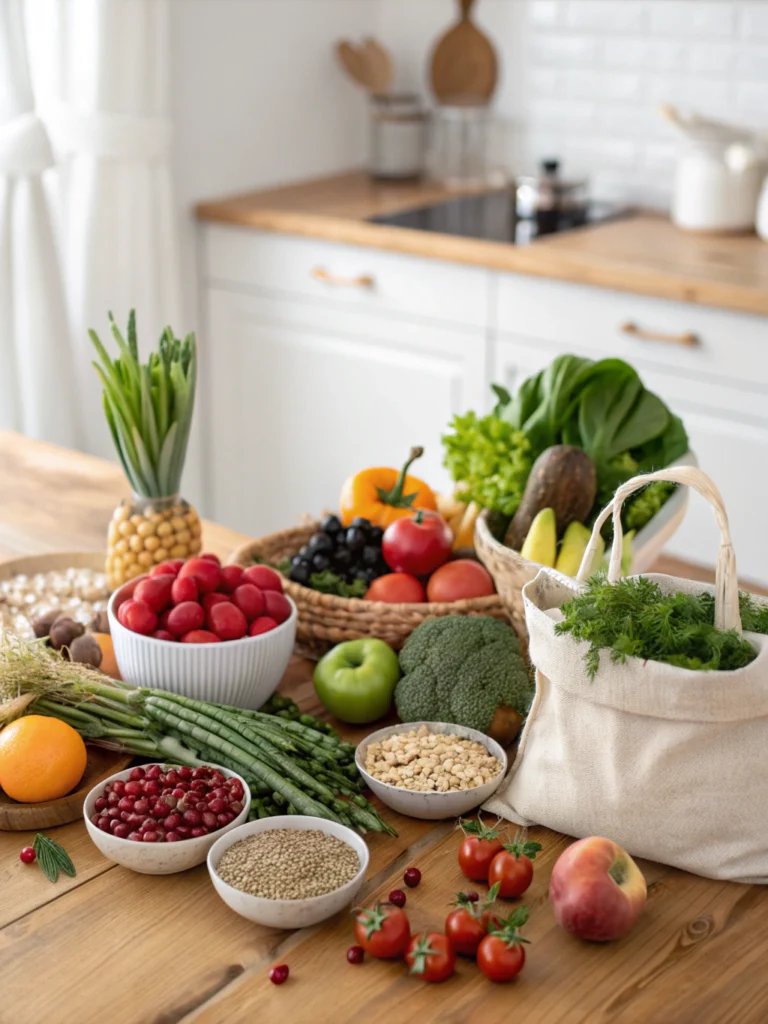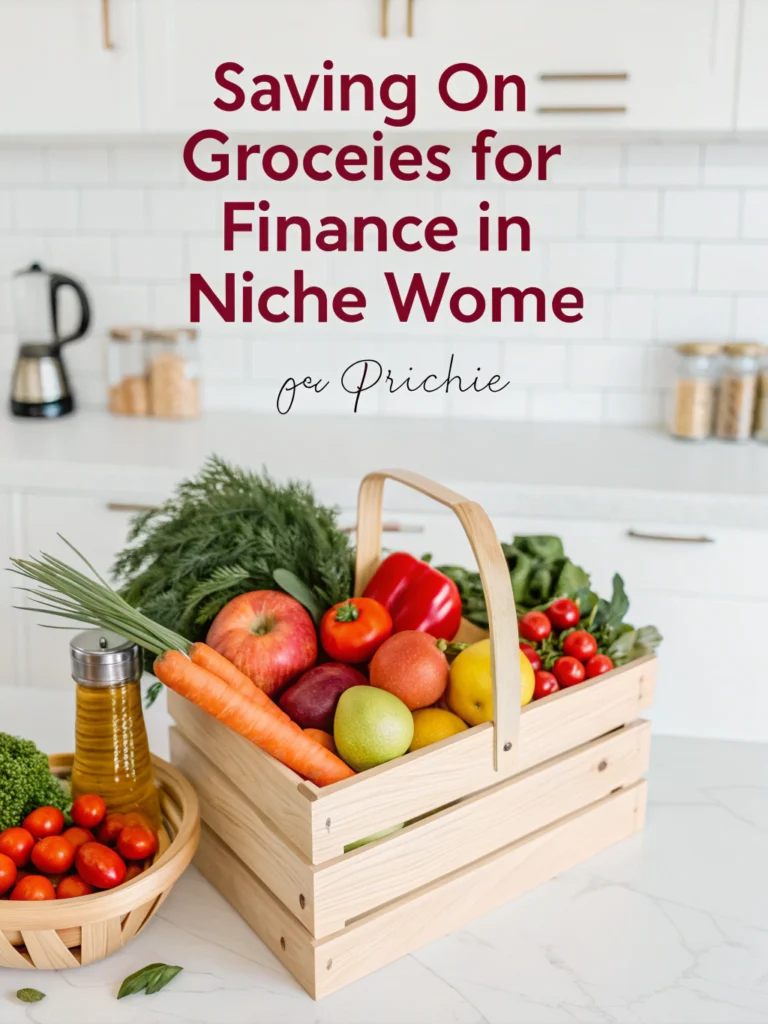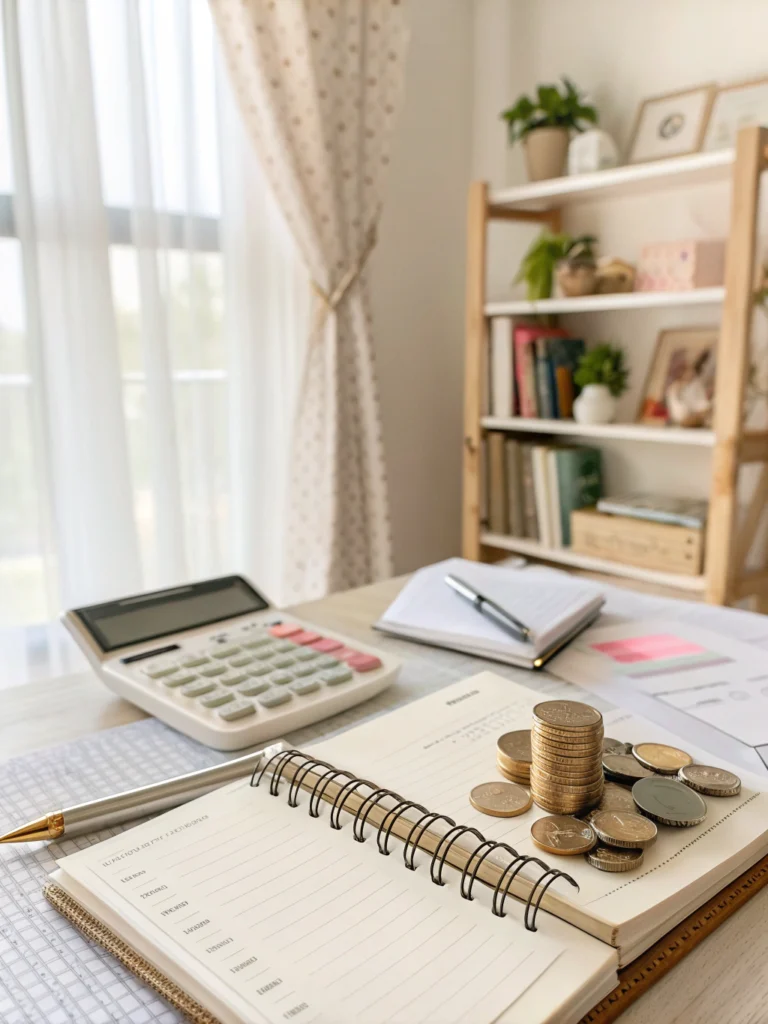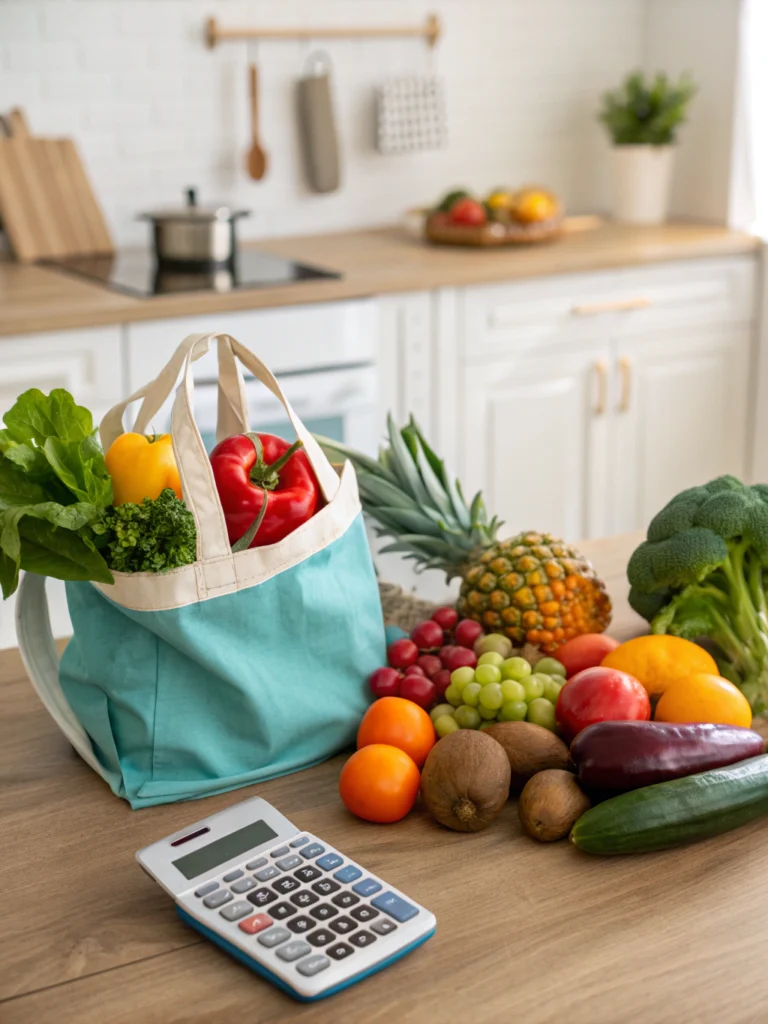Ever find yourself standing in the checkout line, watching the total climb higher and higher, thinking “How did I even spend this much on food?” Yeah, me too. It’s like grocery stores have some secret formula to make our wallets cry. But here’s the good news: learning how to save money grocery shopping isn’t rocket science, and it definitely doesn’t mean you’ll be eating ramen for every meal (unless you want to, no judgment).
The truth is, the average American family tosses about $1,500 a year down the drain on groceries they never actually eat. That’s vacation money, people! And with food prices doing their best impression of a rocket ship lately, figuring out save money on groceries has become less of a “nice-to-have” skill and more of a survival tactic.
In this post, I’m sharing the exact strategies that helped me cut my grocery bill nearly in half without sacrificing the good stuff. We’re talking about how to save money grocery shopping, meal planning hacks, shopping tricks, and budget-friendly tips that actually work in real life, not just on some Pinterest board.
Table of Contents
No time to read the whole post?
Here’s the quick version: Plan your meals before shopping, make a detailed list and stick to it, buy generic brands, shop seasonal produce, use cashback apps, avoid shopping hungry, buy in bulk for staples, compare unit prices, prep meals to avoid waste, and shop sales with coupons. These strategies can easily cut your grocery bill by 30-50% without eating like a college freshman.
10 Tips to Save Money Grocery Shopping
1. Stop Shopping Like You’re on a Game Show
Let’s be real: most of us approach grocery shopping like we’re contestants on “Supermarket Sweep,” grabbing whatever looks good and hoping our bank account survives. Spoiler alert—it usually doesn’t.
The single biggest game-changer for your grocery budget? Meal planning. I know, I know, it sounds boring and time-consuming, but hear me out. When you plan your meals for the week, you buy exactly what you need. No more “mystery vegetables” rotting in your crisper drawer or buying ingredients for a recipe you saw on TikTok at 2 AM but never actually made.
Start small. Pick 4-5 dinners for the week, write down every ingredient you need, and check what you already have at home. This simple step stops you from buying duplicate items (because apparently, I needed four jars of minced garlic?) and keeps you focused in the store.
Pro tip: Plan meals around what’s already on sale that week. Most grocery stores release their weekly ads online. Check them before planning, and build your meals around discounted proteins and produce. If chicken thighs are half off, congrats—you’re eating chicken three ways this week.
2. The Shopping List Is Your Budget’s Best Friend
Once you’ve planned your meals, making a detailed shopping list isn’t optional—it’s mandatory. And here’s the kicker: you actually have to stick to it. Revolutionary concept, right?
I used to think I could wing it at the store. “I’ll just grab what I need,” I’d tell myself confidently. Then I’d come home with artisanal crackers I didn’t need, three impulse candy bars, and somehow no milk. Classic.
Now I organize my list by store section (produce, dairy, meat, etc.) to avoid backtracking through the store. Why does this matter? Because every extra minute you spend wandering the aisles is another opportunity for marketing wizards to convince you that yes, you absolutely need that $12 fancy olive oil.
Use your phone’s notes app, a dedicated app like AnyList, or go old-school with pen and paper. Whatever works, just make the list and treat it like gospel. The only exception? If something you regularly buy is on a killer sale. Then you can audible.
3. Generic Brands Are the Same Thing (Usually)
Here’s something the big brand companies don’t want you to know: store-brand products are often made in the exact same factories as name brands. Same product, different label, way cheaper price tag.
I’m not saying every generic item is identical to its fancy counterpart, but most are shockingly close. We’re talking 80-90% similarity for literally half the price. Things like pasta, canned goods, frozen vegetables, flour, sugar, and basic dairy products? Go generic without hesitation.
Start experimenting. Buy the store brand version of something you normally get, and if you honestly can’t tell the difference in a blind taste test, you’ve just found yourself permanent savings. Over a year, switching just 10 items from name brand to generic can save you anywhere from $500-$1,000. That’s real money.
The exceptions? Sometimes there’s a name-brand item that’s genuinely better and worth the extra cost. For me, it’s peanut butter and coffee. But those are conscious choices, not autopilot purchases.
4. Seasonal Produce Is Your Wallet’s BFF
Buying strawberries in December or butternut squash in July might sound fancy, but your budget will hate you for it. Seasonal produce costs significantly less because it’s abundant, doesn’t require long-distance shipping, and actually tastes better too.
In summer, load up on berries, tomatoes, zucchini, and corn. Fall brings cheaper squash, apples, and root vegetables. Winter means citrus and hearty greens. Spring gives you asparagus, peas, and early berries. Not only will you save money, but you’ll eat better-tasting food that hasn’t traveled 3,000 miles to reach your plate.
Shopping at farmers markets can sometimes offer better deals than grocery stores, especially near closing time when vendors want to unload their inventory. Don’t be shy about asking for bulk discounts if you’re buying larger quantities either.
And here’s a bonus: frozen vegetables are flash-frozen at peak ripeness, often making them more nutritious than “fresh” produce that’s been sitting around for days. Plus, they’re usually cheaper and you won’t waste them. Win-win-win.
5. Technology Can Actually Save You Money (Seriously)
Remember when saving money meant clipping physical coupons from newspapers like our grandparents? Well, now there’s an app for that—actually, there are tons of apps, and they’ll literally pay you to shop.
Cashback apps like Ibotta, Fetch Rewards, and Rakuten give you money back on stuff you’re already buying. You scan your receipt, and boom—cash back. It’s not going to make you rich, but getting $10-$30 back monthly for doing basically nothing? I’ll take it.
Store loyalty programs are also clutch. Most major chains have apps that offer exclusive discounts, digital coupons, and personalized deals based on what you actually buy. Target’s Circle, Kroger’s rewards, Safeway’s Just for U—sign up for whatever stores you frequent. These programs are free and can save you 10-20% per trip.
Also, comparison shop using apps like Flipp or Basket that let you compare prices across different stores without driving all over town. Sometimes it’s worth making two stops if the savings are significant, but you’ve got to factor in your time and gas money too.
6. Never, Ever Shop Hungry (I Mean It)
This sounds like something your mom would say, but science actually backs it up. Studies show people buy 60% more items when shopping hungry compared to shopping on a full stomach. Those hunger pangs make everything look amazing, including things you’d normally never consider.
I learned this lesson the hard way after a post-gym grocery run where I somehow ended up with two frozen pizzas, a rotisserie chicken, chips, and an entire cheesecake. Did I need any of that? Nope. Did my hungry brain convince me otherwise? Absolutely.
Eat a meal or at least a substantial snack before heading to the store. If you’re already out and hungry, grab something small from the store first—a banana or a protein bar—then shop. Your budget will thank you, and you’ll make way better decisions about what actually belongs in your cart.
Also, shopping alone helps if possible. Kids and partners are notorious for sneaking extra items into the cart when you’re not looking. 🙂
7. Bulk Buying: Smart or Stupid?
Buying in bulk can save serious money, but only if you’re strategic about it. The key question: Will you actually use all of it before it expires?
Items that make sense to buy in bulk: non-perishables like rice, pasta, canned goods, toilet paper, cleaning supplies, and anything shelf-stable that you use regularly. These won’t go bad, and the per-unit cost is usually significantly lower.
Items that don’t make sense: fresh produce (unless you’re feeding an army), bread products that’ll go stale, and trendy foods you’re “trying out.” That 5-pound container of quinoa seemed like a great deal until it sat in your pantry for two years because you made it once and weren’t impressed.
Split bulk purchases with friends or family if you want the savings but don’t need massive quantities. Go in together on a Costco membership and divvy up the giant packages. It’s like a very boring, practical version of a timeshare.
8. Unit Pricing Is the Secret Weapon Most People Ignore
Those little price tags on store shelves? They usually show unit pricing (price per ounce, pound, or count) in smaller print. This is arguably the most important number on the shelf, and most people walk right past it.
Bigger packages aren’t always cheaper. Sometimes the medium size is actually the better deal. The only way to know is checking the unit price. Once you start doing this, it becomes second nature and takes like three extra seconds.
This also helps you compare different brands quickly. Yeah, the name brand might be on “sale,” but is it actually cheaper per ounce than the generic? Let the math decide for you.
9. Meal Prep Prevents the Expensive “I Don’t Feel Like Cooking” Moments
Here’s what usually happens: You bought all these groceries with the best intentions. Then Wednesday hits, you’re tired, nothing’s prepped, and suddenly ordering $40 worth of takeout seems totally reasonable. Been there, done that, bought the overpriced T-shirt.
Meal prepping even just a little bit changes everything. I’m not saying you need to become one of those people with 47 identical containers lined up in their fridge (though if that’s your jam, respect). Just do some basic prep work:
Wash and chop vegetables when you get home so they’re grab-and-go. Cook proteins in batches. Make big pots of rice, quinoa, or pasta that you can use throughout the week. Portion out snacks into containers instead of eating from the giant bag (which, let’s be honest, leads to eating the entire giant bag).
When healthy, budget-friendly food is ready to eat, you’ll actually eat it instead of wasting it and spending more money on alternatives. Plus, prepped food means you can throw together meals in 10-15 minutes, which is doable even on your most exhausted evenings.
10. Shop the Sales (But Only for Stuff You Actually Use)
Sales are fantastic when used correctly and dangerous when they trick you into buying stuff you don’t need. That’s their whole game plan, actually.
Create a price book (or just a note on your phone) for items you buy regularly. Track their normal prices so you recognize actual deals versus fake “sales” where they just mark up the price then discount it back to normal. Sneaky, but it happens constantly.
When items you regularly use go on sale, stock up within reason. If pasta’s half price and you eat it twice a week, grab several boxes. If some random exotic fruit you’ve never tried is on sale, maybe skip it—experimentation is great, but not when you’re trying to save money.
Combine sales with coupons for maximum savings. Store sales + manufacturer coupons + cashback apps = the trifecta of savings. It takes a bit more effort but can lead to getting items for 50-75% off or sometimes even free.
Conclusion
Look, learning how to save money grocery shopping doesn’t require you to become an extreme couponer or eat nothing but beans and rice (unless that’s your thing). It’s really about being intentional instead of impulsive, planning instead of winging it, and making small changes that add up to big savings over time.
Start with just two or three of these strategies and build from there. Maybe you start with meal planning and making a list. Once that becomes habit, add in buying generic brands. Then layer in the apps and sales tracking. Before you know it, you’ll be that person who casually mentions cutting their grocery bill in half like it’s no big deal.
Your grocery budget is probably one of the easiest areas to optimize because you have total control over it. You can’t negotiate your rent or mortgage, but you absolutely can decide whether you really need that $8 artisan cheese or if the $4 version will do just fine (spoiler: it usually will).
So grab that shopping list, plan those meals, and show that grocery bill who’s boss. Your future self—and your bank account—will definitely thank you. Now get out there and save some money! 😉






